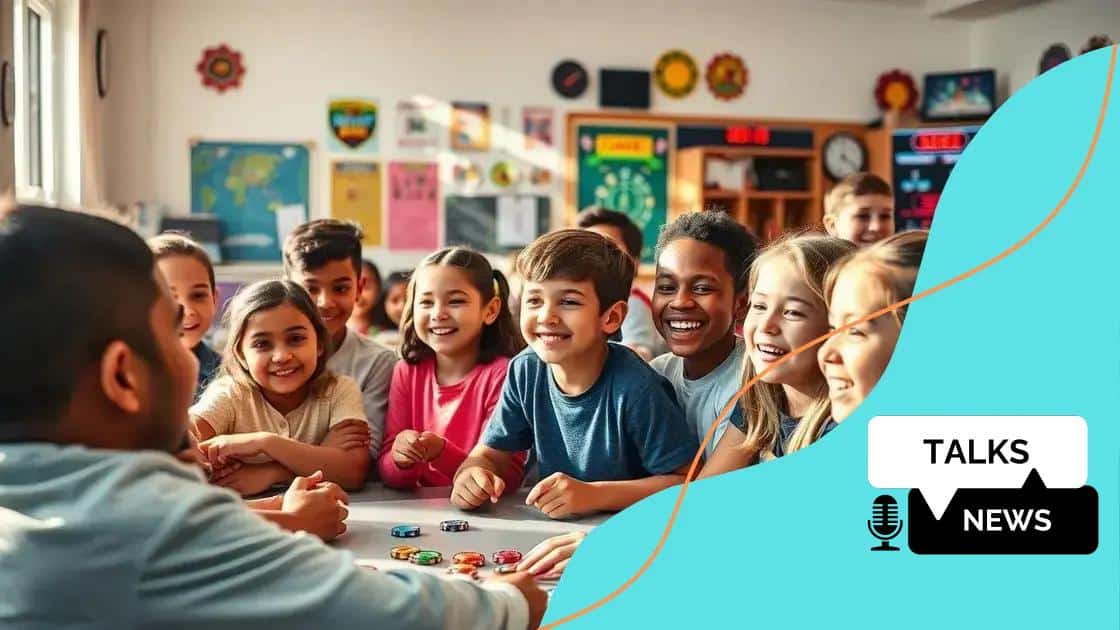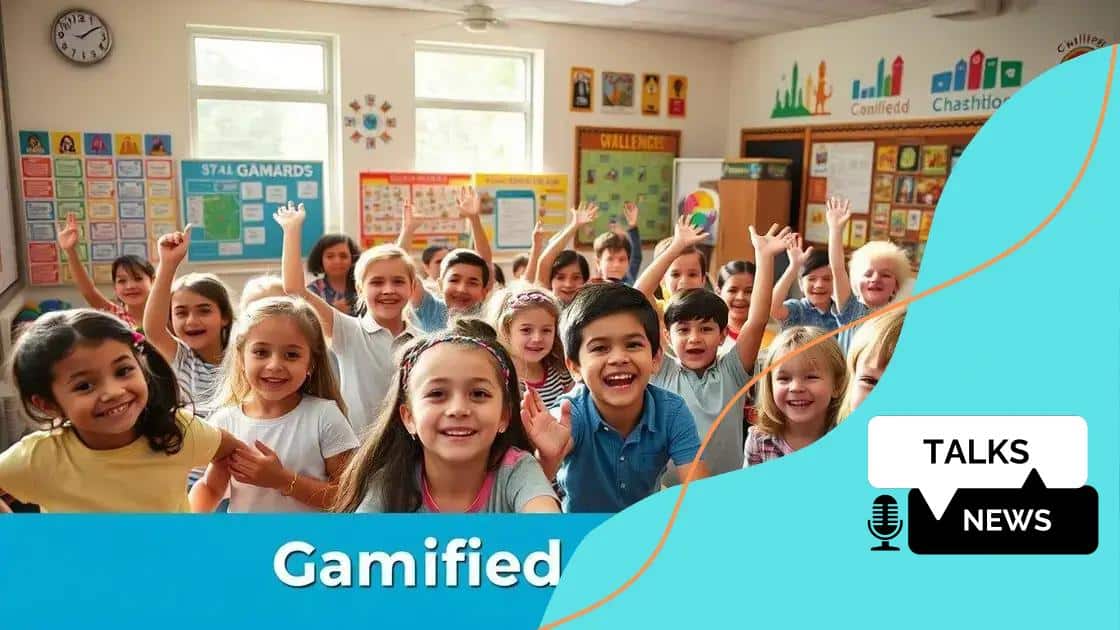Gamification to enhance student engagement effectively

Gamification enhances student engagement by incorporating game elements like points and badges, motivating learners and making education fun and interactive, while also addressing diverse learning needs.
Gamification to enhance student engagement is changing the way educators connect with learners. Have you considered how game elements can make lessons more enticing and effective? Let’s explore this exciting approach.
Understanding gamification in education
Understanding gamification in education is essential for modern teaching strategies. It integrates game design elements into learning, making education more engaging and interactive for students. By incorporating gamification, educators can boost motivation and create a positive learning environment.
Key Elements of Gamification
Gamification relies on specific key elements to be effective. These elements help enhance the learning experience and include:
- Points: Students earn points for completing tasks, motivating them to participate more actively.
- Badges: Digital badges reward achievements, providing students with a sense of accomplishment.
- Leaderboards: Displaying top performers fosters a competitive spirit that encourages engagement.
The incorporation of these elements can transform conventional learning into an exciting adventure. Additionally, rewarding students for their efforts can lead to increased commitment and sustained interest in their studies.
Benefits of Gamification
The benefits of gamification extend beyond mere student engagement. It also enhances retention and encourages collaboration among peers. When students are motivated through game-like activities, they are more likely to remember information and concepts effectively.
Moreover, gamification allows for personalized learning experiences. Educators can tailor challenges and rewards to meet individual student needs, promoting a growth mindset and fostering a love for learning. This adaptability ensures that every student feels valued and encourages them to strive for success.
Benefits of gamification for student engagement
The benefits of gamification for student engagement are vast and impactful. By using game design elements in education, teachers can create lively learning experiences that captivate students. When students become engaged through interactive content, they are more likely to participate actively in their education.
Increased Motivation
One of the greatest advantages of gamification is its ability to boost motivation. Traditional educational methods can sometimes leave students feeling bored. However, when learning resembles the thrill of a game, students are inspired to take part and challenge themselves.
- Challenge: Gamification sets up exciting challenges that push students to excel.
- Rewards: Earning points and badges provides immediate feedback and incentives for progress.
- Fun: Learning becomes enjoyable, and students look forward to lessons.
This increased motivation leads to a positive cycle of learning, where students continuously seek to improve and explore new concepts. They become active participants in their education, rather than passive recipients of information. Additionally, gamification encourages healthy competition, pushing students to perform better and strive for excellence.
Enhanced Retention
Another notable benefit of gamification is enhanced retention of knowledge. Game-like activities help make learning memorable, as students are more likely to remember concepts tied to enjoyable experiences. When students engage with the material through interactive platforms, they form stronger connections with the content.
By using gamification, educators can help students retain information longer. This method also encourages critical thinking and problem-solving skills, as students must navigate challenges effectively. As they receive rewards and recognition, this not only reinforces what they learn but also builds confidence in their abilities.
Effective gamification techniques

Implementing effective gamification techniques can significantly enhance the learning experience in schools. By using various strategies, teachers can motivate students and create a more engaging classroom environment. These techniques can vary widely but share the common goal of making learning enjoyable and effective.
Game Elements to Incorporate
To start, it’s essential to incorporate specific game elements that resonate with students. Some popular elements include:
- Challenges: Creating challenges that require problem-solving can keep students engaged.
- Levels: Establishing different levels of mastery encourages students to progress at their own pace.
- Feedback: Providing immediate feedback helps students understand their performance and areas for improvement.
These elements not only make learning fun but also help in setting clear goals for students. When they have a target to work toward, their motivation increases significantly.
Reward Systems
Another excellent technique is to establish a reward system. Rewards can take many forms, from points for completed tasks to digital badges for achieving particular goals. These rewards create a sense of achievement and recognition among students.
By implementing a system where students earn rewards, you promote a positive learning atmosphere. The anticipation of receiving rewards can motivate students to engage more deeply with the material. Additionally, celebrating milestones can foster a sense of community within the classroom.
Another approach is to integrate storytelling into lessons. By crafting narratives around the lessons, teachers can capture students’ imaginations and help them connect with the content on a deeper level. Story-driven lessons can make subjects more relatable and memorable.
Success stories of gamification
Success stories of gamification in education highlight the transformative power of game-like elements in the classroom. These examples show how implementing gamification techniques can lead to increased student engagement and improved learning outcomes. One notable story comes from a middle school in California, where teachers introduced a gamified reading program.
Engaging Students through Gamified Reading
This program leveraged points and levels to motivate students to read more. Students earned points for each book they finished and could level up after reaching certain milestones. The results were remarkable; not only did reading scores improve, but students became excited about reading, sharing their progress with classmates.
- Increased Participation: More students participated in reading challenges.
- Enhanced Motivation: Students showed a greater desire to read and explore new genres.
- Collaborative Learning: Students formed reading groups to discuss books, fostering teamwork.
Another inspiring success story is from an elementary school that implemented a gamified math program. Teachers used a learning platform that incorporated games to teach math concepts. Through interactive challenges, students built their problem-solving skills while having fun.
Results of the Math Program
The results were impressive, leading to higher test scores and improved confidence among students. They enjoyed participating in activities where they could earn badges and compete on leaderboards, which motivated them to take on difficult math problems.
Many students who struggled academically found success in this gamified setting, proving that the right techniques can produce significant changes. This program demonstrated that gamification not only makes learning engaging but also promotes a strong understanding of the material.
Challenges and considerations in gamification
While there are many benefits to using gamification in education, there are also challenges and considerations that teachers must keep in mind. Understanding these factors can help educators implement gamified strategies more effectively. One common challenge is ensuring that all students can engage with the game elements. Not all learners respond the same way to gamification, and some may feel left out if they struggle with game mechanics.
Inclusivity in Gamification
To create an inclusive environment, educators should consider the diverse needs of their students. This may involve:
- Differentiation: Tailoring activities to cater to varying skill levels.
- Choice: Allowing students to choose how they want to engage with the material.
- Collaboration: Encouraging teamwork, so students can support one another in challenges.
By focusing on inclusivity, teachers can ensure that gamification benefits all students and not just those who excel in competitive settings. Another consideration is the balance between fun and learning. While the goal of gamification is to make learning enjoyable, it should not compromise educational goals.
Balancing Fun and Educational Value
When developing gamified activities, educators must ensure that the learning objectives are clear. The challenges should require students to think critically and apply what they have learned. If activities become too focused on entertainment, students might lose sight of the learning outcomes.
Moreover, implementing gamification can require additional planning and resources. Teachers must invest time in developing new materials, learning platforms, and assessment methods. This preparation can feel overwhelming, especially for educators already managing classroom demands.
Despite these challenges, effective gamification can lead to a highly engaging classroom. With careful consideration and planning, teachers can navigate these hurdles and create an enriching educational experience for students.
FAQ – Frequently Asked Questions about Gamification in Education
What is gamification in education?
Gamification in education involves using game elements like points, badges, and challenges to enhance learning and student engagement.
How does gamification improve student motivation?
By making learning interactive and fun, gamification increases student motivation, encouraging them to participate more actively in their studies.
Are there any challenges in implementing gamification?
Yes, challenges include ensuring inclusivity for all students and balancing fun with educational goals to maintain learning focus.
Can gamification help students with different learning styles?
Absolutely! Gamification can be tailored to accommodate various learning styles, making it accessible and beneficial for all students.





